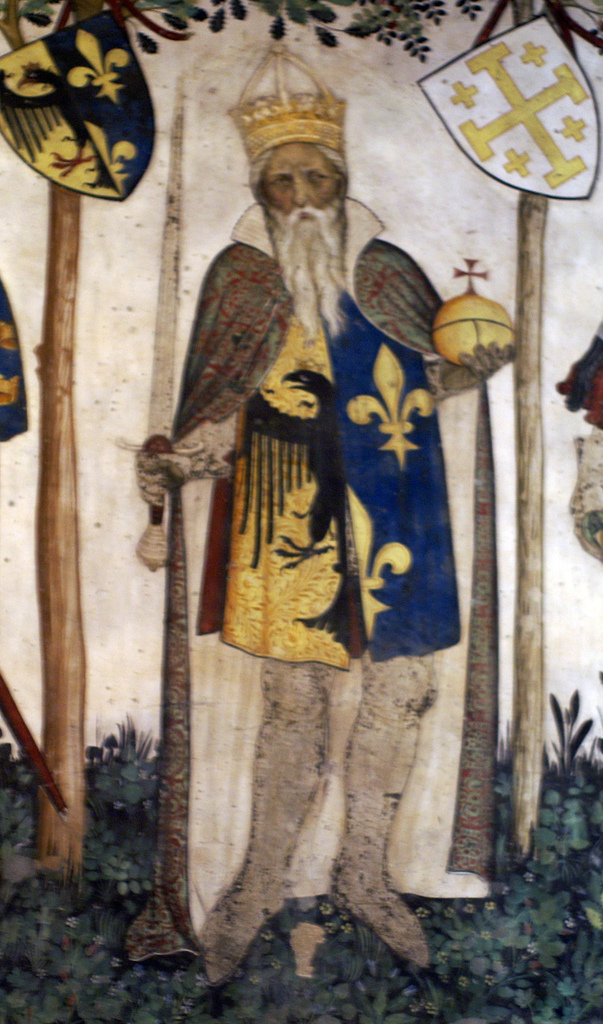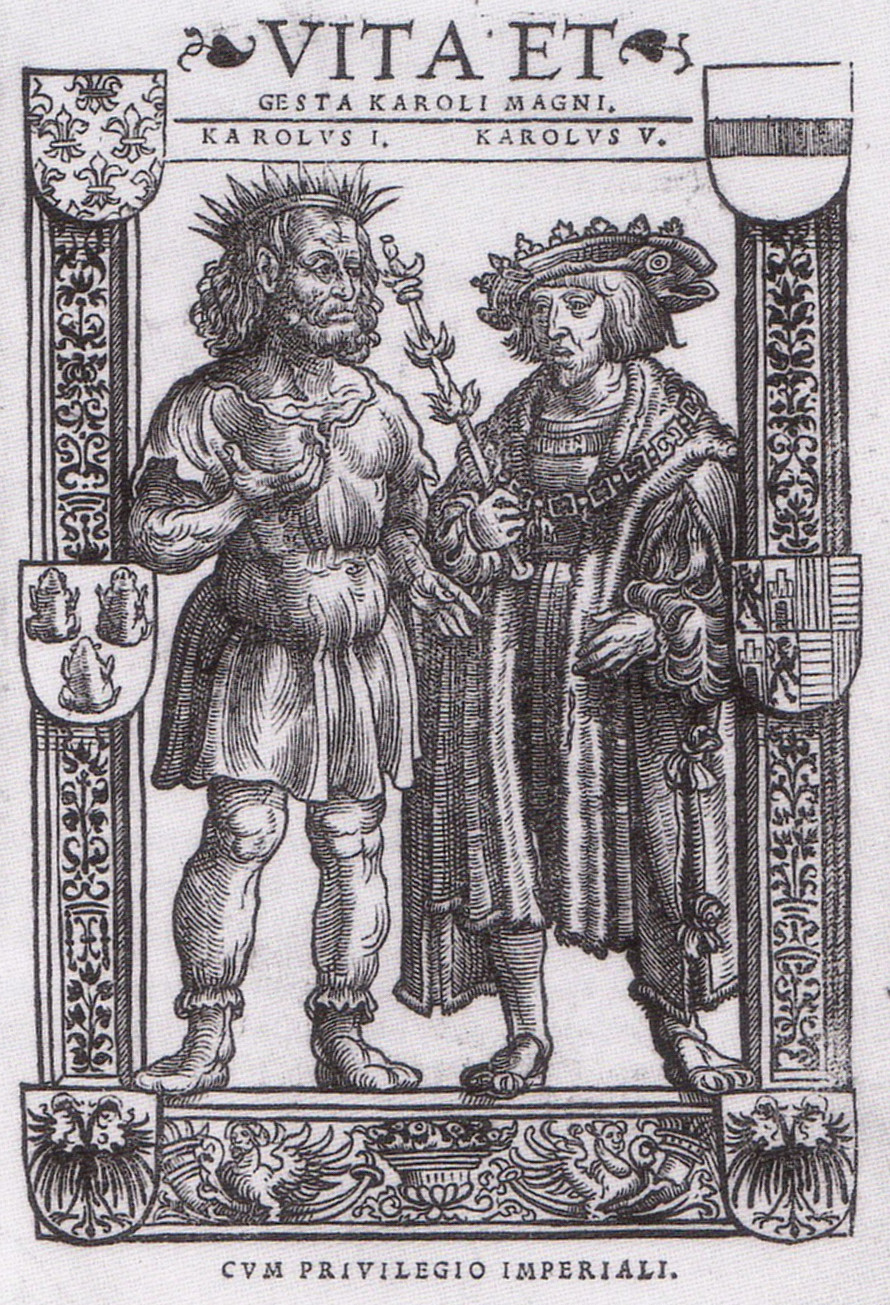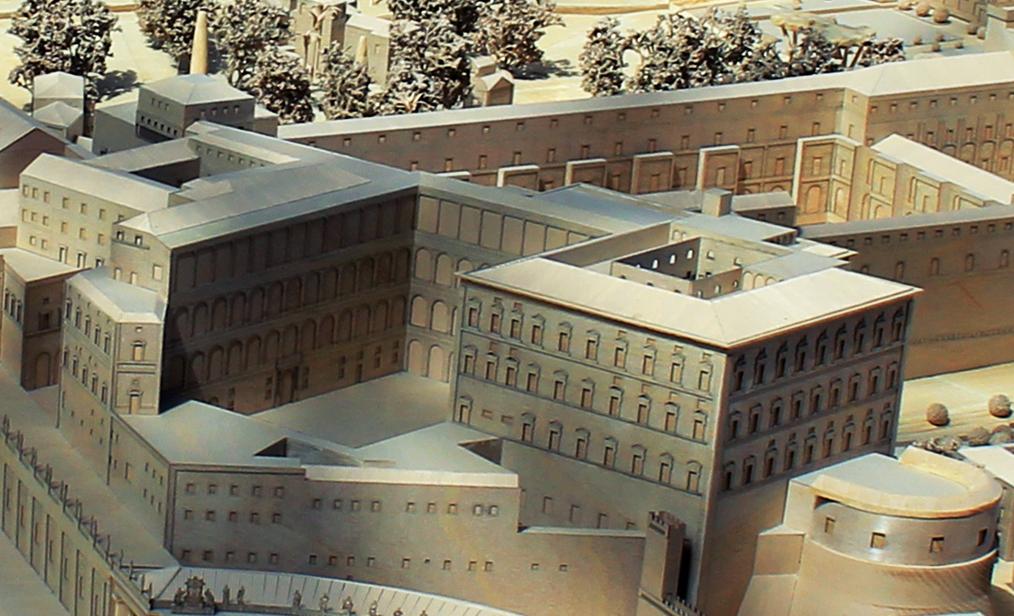|
Iconography Of Charlemagne
The rich iconography of Charlemagne is a reflection of Charlemagne's special position in Europe's collective memory, as the greatest of the List of Frankish kings, Frankish kings, Coronation of the Holy Roman emperor, founder of the Holy Roman Empire, unifier of Western Europe, protector of the Catholic Church, promoter of education and of the Carolingian Renaissance, fictional Le Pèlerinage de Charlemagne, precursor of the crusades, one of the Nine Worthies, a (contested) St. Charlemagne (Master Theodoric), Catholic saint, and a national icon in Andorra, Belgium, France, Germany, Italy, the Netherlands and Switzerland. Appearance The ''Vita Karoli Magni'' written after Charlemagne's death by his servant Einhard has served ever since as a reference establishing his stature and charisma: Beard Contemporaneous depictions of Charlemagne and related rulers suggest he sported a mustache, but not a beard. The motif of Charlemagne's beard appears in 11th-century ''Chanson de geste, ... [...More Info...] [...Related Items...] OR: [Wikipedia] [Google] [Baidu] |
Charles I, Holy Roman Emperor
Charlemagne ( ; 2 April 748 – 28 January 814) was List of Frankish kings, King of the Franks from 768, List of kings of the Lombards, King of the Lombards from 774, and Holy Roman Emperor, Emperor of what is now known as the Carolingian Empire from 800, holding these titles until his death in 814. He united most of Western Europe, Western and Central Europe, and was the first recognised emperor to rule from the west after the fall of the Western Roman Empire approximately three centuries earlier. Charlemagne's reign was marked by political and social changes that had lasting influence on Europe throughout the Middle Ages. A member of the Frankish Carolingian dynasty, Charlemagne was the eldest son of Pepin the Short and Bertrada of Laon. With his brother, Carloman I, he became king of the Franks in 768 following Pepin's death and became the sole ruler three years later. Charlemagne continued his father's policy of protecting the papacy and became its chief defender, remo ... [...More Info...] [...Related Items...] OR: [Wikipedia] [Google] [Baidu] |
Vita Karoli Magni
''Vita Karoli Magni'' (''Life of Charlemagne'') is a biography of Charlemagne, King of the Franks and Holy Roman Emperor, Emperor of the Romans, written by Einhard.Ogg, p. 109 The ''Life of Charlemagne'' is a 33 chapter account starting with the full genealogy of the Merovingian dynasty, Merovingian family, going through the rise of the Carolingian dynasty, Carolingian dynasty, and then detailing the exploits and temperament of King Charles. It has long been seen as one of the key sources for the reign of Charlemagne and provides insight into the court of King Charles and the events that surrounded him. Synopsis The work begins with a preface that is mainly Einhard explaining why he is writing the book, highlighting the idea that he feels it is his duty and that he had such love for Charles that he felt that it would be a tragedy if he was forgotten. The book then moves onto the fall of the Merovingian dynasty, Merovingian family and how the Carolingian dynasty, Carolingian ca ... [...More Info...] [...Related Items...] OR: [Wikipedia] [Google] [Baidu] |
Joyeuse
Joyeuse (; ; meaning 'joyous, joyful') was, in medieval legend, the sword wielded by Charlemagne as his personal weapon. A sword identified as Joyeuse was used in French royal coronation ceremonies since the 13th century, and is now kept at the Louvre. Description The overall height of the sword is with the blade portion making up of that. It is wide at the base, and thick. Its total weight is . In legend Some legends claim Joyeuse was forged to contain the Holy Lance, Lance of Longinus within its Hilt#Pommel, pommel. The blade may have been smithed from the same materials as Roland's Durendal and Ogier the Dane, Ogier's Cortain, Curtana.Bullfinch's Mythology, Legends of Charlemagne, Chapter 24 A children's book from the early 20th century tells that "One priceless thing Charlemagne ever carried in his belt and that was Joyeuse, the Sword Jewellous, which contained in a hilt of gold and gems the head of the lance that pierced our Saviour's side. And thereto he wore a pilgr ... [...More Info...] [...Related Items...] OR: [Wikipedia] [Google] [Baidu] |
Globus Cruciger
The for, la, globus cruciger, cross-bearing orb, also known as ''stavroforos sphaira'' () or "the orb and cross", is an Sphere, orb surmounted by a Christian cross, cross. It has been a Christian Church, Christian symbol of authority since the Middle Ages, used on coins, in iconography, and with a sceptre as royal regalia. The cross laid over the globus represents Christ's dominion over the world, literally held in the hand of a worthy earthly ruler. In the iconography of Art of Europe, Western art, when Christ himself holds the globe, he is called ''Salvator Mundi'' (Latin for 'Saviour of the World'). For instance, the 16th-century Infant Jesus of Prague statue holds a ''globus cruciger'' in this manner. History Holding the world in one's hand, or, more ominously, under one's foot, has been a symbol since antiquity. To citizens of the Roman Empire, the plain spherical globe held by the god Jupiter (mythology), Jupiter represented the world or the universe, as the dominion ... [...More Info...] [...Related Items...] OR: [Wikipedia] [Google] [Baidu] |
Historicism
Historicism is an approach to explaining the existence of phenomena, especially social and cultural practices (including ideas and beliefs), by studying the process or history by which they came about. The term is widely used in philosophy, anthropology, and sociology. This historical approach to explanation differs from and complements the approach known as functionalism, which seeks to explain a phenomenon, such as for example a social form, by providing reasoned arguments about how that social form fulfills some function in the structure of a society. In contrast, rather than taking the phenomenon as a given and then seeking to provide a justification for it from reasoned principles, the historical approach asks "Where did this come from?" and "What factors led up to its creation?"; that is, historical explanations often place a greater emphasis on the role of process and contingency. Historicism is often used to help contextualize theories and narratives, and may be a use ... [...More Info...] [...Related Items...] OR: [Wikipedia] [Google] [Baidu] |
Francis I Of France
Francis I (; ; 12 September 1494 – 31 March 1547) was King of France from 1515 until his death in 1547. He was the son of Charles, Count of Angoulême, and Louise of Savoy. He succeeded his first cousin once removed and father-in-law Louis XII, who died without a legitimate son. A prodigious patron of the arts, Francis promoted the emergent French Renaissance by attracting many Italian artists to work for him, including Leonardo da Vinci, who brought the ''Mona Lisa'', which Francis had acquired. Francis's reign saw important cultural changes with the growth of central power in France, the spread of humanism and Protestantism, and the beginning of French exploration of the New World. Jacques Cartier and others claimed lands in the Americas for France and paved the way for the expansion of the first French colonial empire. For his role in the development and promotion of the French language, Francis became known as (the 'Father and Restorer of Letters'). He was also known ... [...More Info...] [...Related Items...] OR: [Wikipedia] [Google] [Baidu] |
Apostolic Palace
The Apostolic Palace is the official residence of the Pope, the head of the Catholic Church, located in Vatican City. It is also known as the Papal Palace, the Palace of the Vatican and the Vatican Palace. The Vatican itself refers to the building as the Palace of Sixtus V, in honor of Pope Sixtus V, who built most of the present form of the palace. The building contains the papal apartments, various offices of the Catholic Church and the Holy See, private and public chapels, the Vatican Museums, and the Vatican Library, including the Sistine Chapel, Raphael Rooms, and the Borgia Apartments. The modern tourist can see these last and other parts of the palace, but other parts, such as the Sala Regia (Vatican), Sala Regia (Regal Room) and Cappella Paolina, had long been closed to tourists, though the Sala Regia allowed occasional tourism by 2019. The Scala Regia (Vatican), Scala Regia (Regal Staircase) can be viewed from one end and used to enter the Sala Regia. The Cappella Paoli ... [...More Info...] [...Related Items...] OR: [Wikipedia] [Google] [Baidu] |
Raphael Rooms
The four Raphael Rooms () form a suite of reception rooms in the Apostolic Palace, now part of the Vatican Museums, in Vatican City. They are famous for their frescoes, painted by Raphael and his workshop. Together with Michelangelo's Sistine Chapel ceiling frescoes, they are the grand fresco sequences that mark the High Renaissance in Rome. The ''Stanze'', as they are commonly called, were originally intended as a suite of apartments for Pope Julius II. He commissioned Raphael, then a relatively young artist from Urbino, and his studio in 1508 or 1509 to redecorate the existing interiors of the rooms entirely. It was possibly Julius' intent to outshine the apartments of his predecessor (and rival) Pope Alexander VI, as the ''Stanze'' are directly above Alexander's Borgia Apartment. They are on the second floor, overlooking the south side of the Belvedere Courtyard. Running from east to west, as a visitor would have entered the apartment, but not following the sequence in which ... [...More Info...] [...Related Items...] OR: [Wikipedia] [Google] [Baidu] |
The Coronation Of Charlemagne
''The Coronation of Charlemagne'' is a painting by the workshop of the Italian Renaissance artist Raphael. Though it is believed that Raphael did make the designs for the composition, the fresco was probably painted by Gianfrancesco Penni. The painting was part of Raphael's commission to decorate the rooms that are now known as the '' Stanze di Raffaello'', in the Apostolic Palace in the Vatican. It is located in the room that was named after ''The Fire in the Borgo'', the ''Stanza dell'incendio del Borgo''. The painting shows how Charlemagne was crowned Imperator Romanorum by Pope Leo III (pontiff from 795 to 816) on Christmas Evening, 800. Behind Charlemagne, a child page holds the royal crown that he just took off to receive the imperial one. It is quite likely that the fresco refers to the Concordat of Bologna, negotiated between the Holy See and the kingdom of France in 1515, since Leo III is in fact a portrait of Leo X and Charlemagne a portrait of Francis I. According to ... [...More Info...] [...Related Items...] OR: [Wikipedia] [Google] [Baidu] |
Battle Of Roncevaux Pass
The Battle of Roncevaux Pass ( French and English spelling, '' Roncesvalles'' in Spanish, ''Orreaga'' in Basque) in 778 saw a large force of Basques ambush a part of Charlemagne's army in Roncevaux Pass, a high mountain pass in the Pyrenees on the present border between France and Spain, after his invasion of the Iberian Peninsula. The Basque attack was in retaliation for Charlemagne's destruction of the city walls of their capital, Pamplona. As the Franks retreated across the Pyrenees back to Francia, the rearguard of Frankish lords was cut off, stood its ground, and was wiped out. Among those killed in the battle was Roland, a Frankish commander. His death elevated him and the paladins, the foremost warriors of Charlemagne's court, into legend, becoming the quintessential role model for knights and also greatly influencing the code of chivalry in the Middle Ages. There are numerous written works about the battle, some of which change and exaggerate events. The battle is re ... [...More Info...] [...Related Items...] OR: [Wikipedia] [Google] [Baidu] |
La Légende Des Siècles
''La Légende des siècles'' (, ) is a collection of poems by Victor Hugo, conceived as an immense depiction of the history and evolution of humanity. Written intermittently between 1855 and 1876 while Hugo worked in exile on numerous other projects, the poems were published in three series in 1859, 1877, and 1883. Bearing witness to the unparalleled poetic talent evident in all Hugo's art, the ''Légende des Siècles'' is often considered the only true French epic and, according to Baudelaire's formulation, the only modern epic possible. The dreaming poet contemplates the "wall of the centuries," indistinct and terrible, on which scenes of the past, present and future are drawn, and along which the whole long procession of humanity can be seen. The poems are depictions of these scenes, fleetingly perceived and interspersed with terrifying visions. Hugo sought neither historical accuracy nor exhaustiveness; rather, he concentrated on obscure figures, usually his own inventions, wh ... [...More Info...] [...Related Items...] OR: [Wikipedia] [Google] [Baidu] |
Victor Hugo
Victor-Marie Hugo, vicomte Hugo (; 26 February 1802 – 22 May 1885) was a French Romanticism, Romantic author, poet, essayist, playwright, journalist, human rights activist and politician. His most famous works are the novels ''The Hunchback of Notre-Dame'' (1831) and ''Les Misérables'' (1862). In France, Hugo is renowned for his poetry collections, such as and (''The Legend of the Ages''). Hugo was at the forefront of the Romanticism, Romantic literary movement with his play ''Cromwell (play), Cromwell'' and drama ''Hernani (drama), Hernani''. His works have inspired music, both during his lifetime and after his death, including the opera ''Rigoletto'' and the musicals ''Les Misérables (musical), Les Misérables'' and ''Notre-Dame de Paris (musical), Notre-Dame de Paris''. He produced more than 4,000 drawings in his lifetime, and campaigned for social causes such as the abolition of Capital punishment in France, capital punishment and Abolitionism, slavery. Although he ... [...More Info...] [...Related Items...] OR: [Wikipedia] [Google] [Baidu] |








